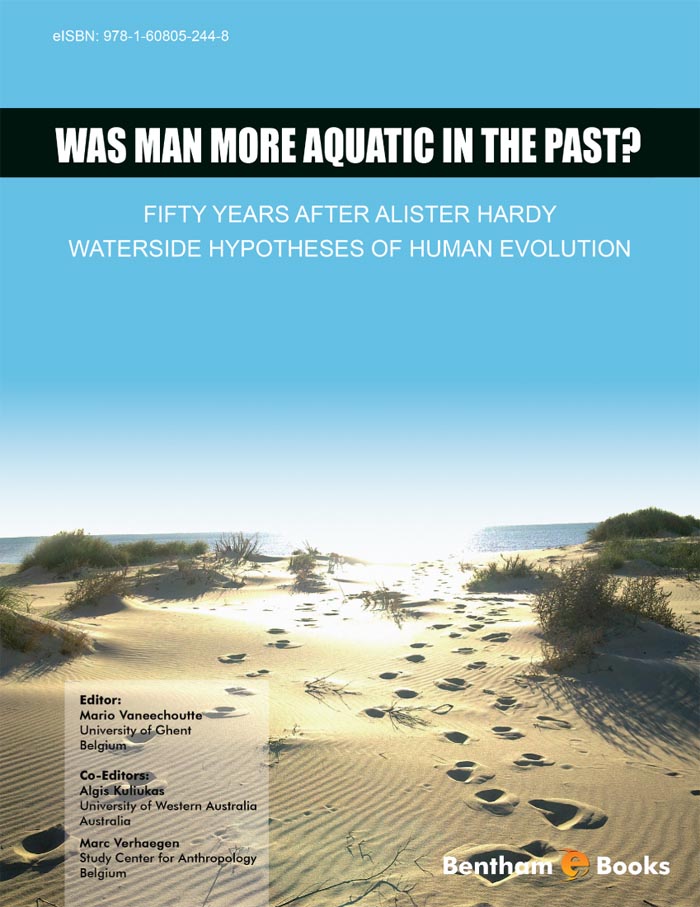This book attempts to provide an explanation for the remarkable observation that the differences between our species, Homo sapiens, and our nearest relatives, the chimpanzees, are more numerous, more varied and more radical than between any other two species that are genetically so closely related. In many respects, such as our nakedness, bipedalism, brain size, profuseness of sweating, strongly increased subcutaneous fat, voluntary breathing control, a disproportionately large brain, and the power of speech, our species markedly differs, not merely from other apes, but also from the vast majority of other terrestrial mammals.
Should we explain all of these peculiarities by assuming that our ancestors moved out from the tropical forests to live on the open plains and become hunters, as we uniformly can read in every textbook and learn from every television documentary, since decades? Or, are these characteristics more 'parsimoniously' explained by assuming that, rather than striding or running across the grassy plains, our ancestors may have spent one or more periods of their evolution wading, swimming and diving in shallow waters. Some people find that idea counter-intuitive, and so did I when Marc Verhaegen first confronted me with it some ten years ago. After all, hadn't I been terribly afraid of water until my tenth, learning to swim only at the age of twelve - with much trouble? (As was the case for Marc!, as he told me recently). According to the ethologist Dirk Meijers, we may have missed a critical imprinting period, during which swimming for a baby comes natural.
However, as I learned more about the aquatic ape hypothesis (AAH), several of the arguments put forward by its proponents struck me as intriguing and worth pursuing. But the reception accorded to this suggestion was so dismissive, ranging from outright hostility to - at best - a deafening silence, that my initial interest in the AAH was philosophical in the first place, trying to understand this kind of reaction. When the aquatic theory was referred to at all, the most frequent grounds for rejection consisted not of disputing the arguments put forward, but instead stressing that they were being advanced by people who were unqualified to express any opinion on the matter. Its first English proponent, Alister Hardy, was a marine biologist [1], and Elaine Morgan, author of the most persistent attempts to make it more widely known [2], had been a television scriptwriter (see Chapters 13 and 14). The only official response addressing the AAH so far [3] (see Chapter 15), in fact also depicted the AAH at the same level of creationism and of explanations that include invoking aliens from space, and considered the AAH just as "only one of several ideas rejected by orthodox science that has refused to go away."
The belief in our savannah past has become so deeply rooted that, even when Phillip V. Tobias, one of its most eminent former promoters, - as the mental heir of Raymond Dart, who proposed and defended the open plains theory most explicitly [4], - publicly and explicitly disavowed it, (see Chapter 1), this did very little to shake his colleagues' faith in it.
At the end of this book, Tess Williams (Chapter 14) reviews the different reasons that may be at the basis of this way of reacting by the scientific establishment. My personal understanding is that such neglect and/or hostility can be regarded as a quite understandable, emotional, response, which can be observed rather often when new ideas pop up. Indeed, it is often overlooked that new ideas, which contradict established theories, also threaten the lifelong work and achievements of many individuals, i.e. established scientists.
This occurs whenever a paradigm that has long commanded consensus turns out to be flawed and needs replacing. Thomas S. Kuhn, in his treatise on The structure of scientific revolutions [5], provided some illuminating examples of what happens then. The new idea is reviewed by the great and good who have invested a lifetime in upholding and building on the old idea, which has brought them scientific appreciation, which they have taught for decades to hundreds of students and on which they have published in highly-valued journals, supported by so many highly-valued peers. They speak with one voice in condemning anyone who dares to threaten it. Hence, the new paradigm can only be promoted by outsiders.
In fact, I would not be too surprised if one day when the AAH has become the established orthodoxy - and the authors of this book are convinced that that day is not far off - its supporters would close ranks in exactly the same way against any even newer idea that threatened to supersede it.
The resistance against a partially aquatic past of our ancestors is even more intriguing when we consider the 'scientific' basis for the open plain theory of our past. Indeed, the theory that we fell out of the trees and started walking on our hind legs on the ground is not based on scientific scrutiny, but on the endless repetition of what looks a straightforward sequence of events, only at first sight. It seems that, if only an idea is repeated numerous times, it becomes established truth and generally accepted wisdom, which needs no further evidence, and which becomes almost impossible to tackle. (See also Bender [6] for a description of the history of the 'savannah' hypothesis).
So far the philosophy, with the hope that this book finally puts the AAH at the level at which it should have been treated since decades: as a sound alternative and possibly powerful explanation of many of the peculiar characteristics of our species. But the content of the AAH and the predictions it may enable to make are even more intriguing than the philosophical debate of why it encounters so much resistance. Yes, I have become a 'believer' in the meantime, and even more so after reading the diverse contributions to this book.
One of the reasons of why the AAH is worth considering is that it is supported by findings from so many different lines of research. Breathing physiology research (see Chapter 7), vision research (see Chapters 10 and 11), obstetrics (see Chapter 9), nephrology (see Chapter 8), brain development research (see Chapters 2, 5 and 12) and skin biology (see Chapter 2), among many other disciplines, all point to a semi-aquatic past and to the importance of this past still in our present day lives. This underlines what is one of the greatest strengths of the AAH: Other theories have set out to account for one or two of the several anomalies that characterize human morphology and physiology, but none even attempts to find a common thread that could, just conceivably, throw light on many of them simultaneously.
Moreover, adopting the view that much of our current physiology is explainable as 'scars' of an evolution that was partially aquatic, may contribute to better understanding of several ill-comprised medical problems. Some were already addressed in the books of Elaine Morgan, in an article by Marc Verhaegen [7], and others are dealt with, albeit briefly, in this book, e.g. in Chapter 10, with regard to obstetrical problems.
Not only our bodies, but also some of our social behavior may have been strongly influenced by an aquatic past, and part of our behavior is maybe better understood when viewing ourselves as a pair-bonding, water-adapted and musical ape, rather than from the present-day Man-the-hunter story.
In summary, it is long overdue to consider the possible influence of aquatic adaptations in our past evolution over the last 5 million years, since the split with the chimpanzee, not only because this may provide the best explanation of many of our peculiarities, but also because it may bring us practically useful and important insights in who we are and in how it affects our present-day health.
Having had the opportunity and the honour of editing the different chapters in this book, it is clear to me that the burden of proof now rests on the opponents of the aquatic ape hypothesis, or maybe better, semi-aquatic ancestor hypothesis. After first having progressed from being a sceptic to becoming an interested bystander, I am now convinced - because of overwhelming support from very different lines of research, all pointing in one direction - that we need a thorough reappraisal of the events that may have caused us to differ so profoundly from all other anthropoids, eventually by adopting a wetter view of our ancestry.
The editors thank Christian De Boever for excellent assistance in lay-out.
References
[1] Hardy A. Was Man more aquatic in the past? New Sci 1960; 7: 642-5.
[2] Morgan E. The descent of woman. London: Souvenir Press 1972.
[3] Langdon JH. Umbrella hypotheses and parsimony in human evolution: A critique of the aquatic ape hypothesis. J Hum Evol 1997; 33: 479-94.
[4] Dart RA. Australopithecus africanus: The man-ape of South Africa. Nature 1925; 115: 195-9.
[5] Kuhn TS. The structure of scientific revolutions. Chicago: University of Chicago Press 1962.
[6] Bender, R. Die evolutionsbiologische Grundlage des menschlichen Schwimmens, Tauchens und Watens: Konvergenzforschung in den Terrestrisierungshypothesen und in der Aquatic Ape Theory. PhD dissertation at the Institut für Sport und Sportwissenschaft, Universität Bern, Switzerland 1999.
[7] Verhaegen MJB. The aquatic ape theory and some common diseases. Med Hypoth 1987; 24: 293-9.





